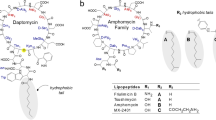Abstract
Lysostaphin digestion of peptidoglycan (PG) from Staphylococcus aureus resulted in chromosomal DNA fragmentation by released DNase, as directly visualized in situ on isolated nucleoids. Nevertheless, DNA digestion was partially prevented by previous incubation with antibiotics that inhibit PG synthesis. This inhibitory effect was much more remarkable with glycopeptides vancomycin and mainly teicoplanin than with beta-lactams cloxacillin and ceftazidime. Therefore, inhibition of PG chain elongation has a more significant inhibition of DNA degradation than inhibition of PG cross-linking, possibly due to a reduction in DNase storage at the cell wall.





Similar content being viewed by others
References
Ahnström G (1988) Techniques to measure DNA strand breaks in cells: a review. Int J Radiat Biol 54(5):695–707
Bayles KW (2007) The biological role of death and lysis in biofilm development. Nat Rev Microbiol 5(9):721–726
Beauregard DA, Williams DH, Gwynn MN, Knowles DJ (1995) Dimerization and membrane anchors in extracellular targeting of vancomycin group antibiotics. Antimicrob Agents Chemother 39(3):781–785
Berenders ETM, Horswill AR, Haste NM, Monestier M, Nizet V, von Köckritz-Blickwede M (2010) Nuclease expression in S. aureus facilitates escape from neutrophil extracellular traps. J Innate Immun 2:576–586
Fernández JL, Cartelle M, Muriel L, Santiso R, Tamayo M, Goyanes V, Gosálvez J, Bou G (2008) DNA fragmentation in microorganisms assessed in situ. Appl Environ Microbiol 74(19):5925–5933
Francius G, Domenech O, Mingeot-Leclercq MP, Dufrêne YF (2008) Direct observation of S. aureus cell wall digestion by lysostaphin. J Bacteriol 190(4):7904–7909
Ghuysen JM (1991) Serine beta-lactamases and penicillin-binding proteins. Annu Rev Microbiol 45:37–67
Kahne D, Leimkuhler C, Lu W, Walsh C (2005) Glycopeptide and lipoglycopeptide antibiotics. Chem Rev 105(2):425–448
Kateete DP, Kimani CN, Katabazi FA, Okeng A, Okee MS, Nanteza A, Joloba ML, Najjuka FC (2010) Identification of S. aureus: DNase and Mannitol salt agar improve the efficiency of the tube coagulase test. Ann Clin Microbiol Antimicrob 9:23
Kiri N, Archer G, Climo MW (2002) Combinations of lysostaphin with beta-lactams are synergistic against oxacillin-resistant S. epidermidis. Antimicrob Agents Chemother 46(6):2017–2020
Kumar JK (2008) Lysostaphin: an antistaphylococcal agent. Appl Microbiol Biotechnol 80(4):555–561
Labischinski H, Maidhof H (1994) Microbial peptidoglycan (murein) hydrolases. In: Ghuysen M, Hakenbeck R (eds) Bacterial cell wall, vol 27. Elsevier Science B.V, Amsterdam, pp 23–28
Lagace-Wiens PRS, Alfa MJ, Manickam K, Karlowsky JA (2007) Thermostable DNase is superior to tube coagulase for direct detection of S. aureus in positive blood cultures. J Clin Microbiol 45(10):3478–3479
Okabayashi K, Mizuno D (1974) Surface-bound nuclease of S. aureus: localization of the enzyme. J Bacteriol 117(1):215–221
Ranjit D, Chandramohan L, Tsang LH, Smeltzer MS, Horswill AR, Bayles KW (2009) Modulation of eDNA release and degradation affects S. aureus biofilm maturation. PLoS One 4(6):e5822
Santiso R, Tamayo M, Gosálvez J, Bou G, Fernández MC, Fernández JL (2011) A rapid in situ procedure for determination of bacterial susceptibility or resistance to antibiotics that inhibit peptidoglycan biosynthesis. BMC Microbiol 11:19
Tamayo M, Santiso R, Gosálvez J, Bou G, Fernández JL (2009) Rapid assessment of the effect of ciprofloxacin on chromosomal DNA from Escherichia coli using an in situ DNA fragmentation assay. BMC Microbiol 9:69
Tang J, Zhou R, Shi X, Kang M, Wang H, Chen H (2008) Two thermostable nucleases coexisted in S. aureus: evidence from mutagenesis and in vitro expression. FEMS Microbiol Lett 284(2):176–183
Thomas EA, Thomas CA (1989) Nucleoid halo expansion indirectly measures DNA damage in single cells. Exp Cell Res 183(1):149–158
Wu W, Kusuma K, Mond JJ, Kokai-Kun JF (2003) Lysostaphin disrupts S. aureus and S. epidermidis biofilms on artificial surfaces. Antimicrob Agents Chemother 47(11):3407–3414
Acknowledgments
We are grateful to prof. Steve Johnston, University of Queensland, Australia, for the critical reading of the manuscript and improving of the English style. This work has been supported by grants from the European Community, FP 7, ID: 278232 (MagicBullet), and from the Xunta de Galicia 10CSA916020PR.
Conflict of interest
The authors declare that there are no conflicts of interest.
Author information
Authors and Affiliations
Corresponding author
Additional information
Communicated by John Helmann.
Rights and permissions
About this article
Cite this article
Tamayo, M., Santiso, R., Gosálvez, J. et al. Cell wall active antibiotics reduce chromosomal DNA fragmentation by peptidoglycan hydrolysis in Staphylococcus aureus . Arch Microbiol 194, 967–975 (2012). https://doi.org/10.1007/s00203-012-0831-0
Received:
Revised:
Accepted:
Published:
Issue Date:
DOI: https://doi.org/10.1007/s00203-012-0831-0




